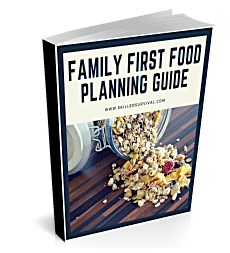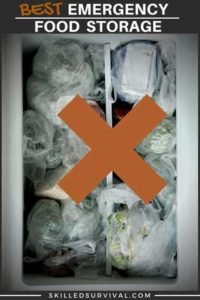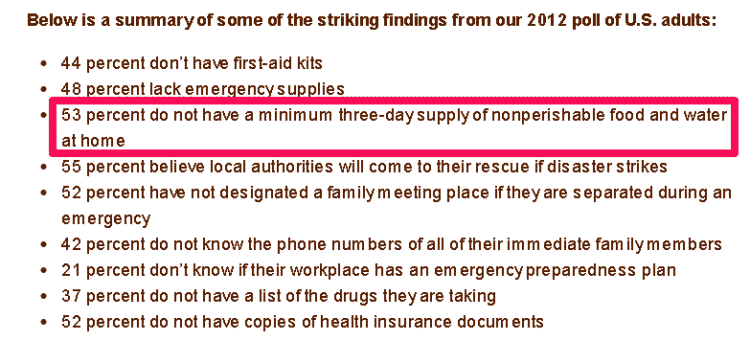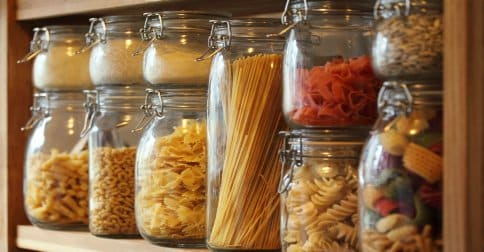A Complete Guide To Building An Emergency Food Storage System
But…storing extra food is easy, right? Just buy a bunch of random foods and stuff them in your pantry. NOT SO FAST… THAT’s a recipe for disaster.
Instead, you need a better plan. An emergency food storage system that will last for years (and perhaps even decades).
TOPICS IN THIS GUIDE… ↓(click to jump)
- Never Rely On Your Freezer
- Basic Food Storage Principles
- Best Ways To Get Started
- “DIY,” Vs “Done For You?
- Saving Money On Foods
- What Exactly You Should Buy
- Maintaining Your Food Supply
- Using Food As A Bargaining Tool
Never Rely Only On Your Freezer
Right now, I’ve got a large chest freezer in my basement. It stores heaps and heaps of delicious and nutritious foods. All waiting patiently for their turn at my dinner table. Large chest freezers are a modern convenience.
One you should definitely consider for your family.
- You can store extra meats, cheeses, bread, and desserts when you find them on clearance.
- You can be ready for large family visits and holiday dinners.
There are many reasons for owning and utilizing a large freezer, but survival food storage isn’t one of them. I cannot think of a single catastrophic event where a reliable grid power is a part of it:
- Natural disasters? No
- Civil Unrest and Riots? Nope
- Terrorist Nuclear Attacks? Nada
- EMP Attack? No way
That’s why it is so important for your emergency food storage to be grid-Independent. Freezers are grid-DEPENDENT appliances.
When The Grid Goes Down, Your Freezer Stops Freezing.
Now maybe you get lucky, and the power goes in in the winter. Or you might have an emergency solar generator that can turn on and off strategically throughout the day. Thus keeping your frozen goods safe for weeks. But what if you’re unlucky, and grid power goes out in the middle of a heatwave?
Regardless, your freezer chest is tied to the word LUCK. Luck should never be a part of your preparedness vocabulary. You will lose most of your frozen foods in a long-term survival scenario with no grid power.
Sure, you can salvage some of it… Bread will last for a few weeks, and cheeses won’t go bad overnight. But the meats… You will lose your meats within days.
You should cook and eat as much meat as possible right away. But it will be a losing battle. Plus, the problem of indecision comes into play.
Will the grid power come back on within a few days? Then it’s best to leave the freezer closed and traps as much cold air as possible. Will it be a longer-term weeks/months grid failure? Then you should start cooking and eating as much meat as possible.
Soon, you’ll have a problem with what to do with all the rotten meat. It will get rancid, and inadequate disposal methods will attract unwanted attention (neighbors, rodents, and wild animals).
I hope you get my point…
A large stocked freezer is NOT a reliable emergency food tool.
What about your local grocery store? You cannot rely on the grocery store for your emergency food stockpile. Because, in a real emergency, it will empty in hours. And won’t get restocked. You could have all the money in the world; with nothing to buy.
So you should focus on high-quality freeze-dried meals, long-shelf life foods, and stock rotation. Just because you don’t have any survival food yet, doesn’t mean it’s too late.
Start today, and you’ll be better off for it. If you are like most people, the amount of non perishable food you have in your pantry right now might last only a few days…
I call these folks “The Fragile Masses” and they choose to live a life fragile to the future:
↓ The Surprising Reason People Live A Fragile Life
Basic Survival Food Storage Principles
So you want to start building your emergency food stockpile but don’t know where to start? There are a few principles to keep in mind:
- Food should be non-perishable. Foods include freeze-dried meals, canned goods, dried foods in bulk, or dried meat products like pemmican. These food materials can last for the long term, up to decades, if sealed properly, which means you will have food for even the worst-case scenarios.
- Consider buying processed food. No, it’s not as healthy. But it lasts longer. Plus, starvation is even worse for your health than processed foods. So you can worry about restoring your health once the crisis ends; until then, focus on surviving day by day.
- Store your food supplies somewhere cool and dry. A dry basement is ideal and works to keep food storage dry, cool. Just make sure it’s protected from vermin and the elements.
- Figure out how many calories each family member needs per day. Then calculate how much food you need to meet your goals.

Want a free family-first food planning guide?
Enter your email below to instantly download this Complete Guide PDF. No purchase necessary. 👇 👇Variety is more important than you think. Morale will already be low. And kids (or grandkids) will be scared and unsure of what to do. When the future looks bleak, it doesn’t help by eating the same thing daily. So include a variety of tastes and textures with your emergency food supplies.
It can really help keep spirits up.
Convenience is important, too. If you have food you can eat directly from its packaging without cooking it, be sure to utilize that. Canned meats are good for this. Just open the package, and eat.
How To Start Building Your Stockpile
If you live in a smaller home or an apartment, finding places to store your food can be challenging. The first step is to search out unique food storage ideas.
- Do you have an unused cabinet space?
- What about a closet in a guest room that goes virtually untouched?
Another alternative is to find places that are used only for storage and clean them out. Get rid of items you don’t need! Once done, there will be plenty of spaces for that extra food.
Building up at stockpile of survival food involves planning, coordination, and preparation. You can start slowly; but start, you must. Sit down and calculate your family’s minimum nutritional needs.
- What is your daily calorie intake?
- What do you need to survive?
- Are there any special dietary requirements for anyone in your family?
All of these questions are important, so take notes. Create a document with all of this information (a physical copy, not a digital one). And keep it hidden with your supplies. This process may take some time, but they’re family, so it’s worth it!

Want a free family-first food planning guide?
Enter your email below to instantly download this Complete Guide PDF. No purchase necessary. 👇 👇“Do It Yourself,” “Done For You,” or Both?
IF this is ALL new to you, start with a three-day supply. This will last you through most minor problems like a power outage from a storm or a blimp with the power company. Once you have a three-day supply, focus on building up 2 weeks.
Two weeks will be sufficient for 99% of situations. Issues ranging from mass evacuations because of a natural disaster to localized attacks on the power grid.
Then, over the next several months, focus on building up a one-month supply. Then shoot for a year.
If you prefer a faster, simpler method, purchase bulk freeze dried food buckets online. I personally use Valley Food Storage. They have lots of options at different price points to choose from.

With Valley Food Storage, you’ll:
- Get ready sooner
- Have peace of mind sooner
- Get very high-quality packaging and storage buckets
- Get delicious and a good variety of food
I recommend you do some DIY and Done For You. That way, if something happens next week, you’ll be OK (for a few days…) Once you’ve got an initial order in, continue to build on that each month.
Here is a review and taste test of Valley Food Storage freeze-dried meals.
↓ Valley Food Storage Review & Unboxing
Here’s a video of me purchasing from Valley Food Storage to top off my supplies.
↓ Valley Food Storage Purchase
Now you take a deep breath. You’re now more resilient than the “fragile masses”. And eventually, with enough emergency food storage it can be your bartering chip in the event of an economic collapse.
If the country ever goes to war on its own soil, a one-year survival food kit could become your family’s lifeline. You will eat and can use some to barter with others. More on barter shortly…

Want a free family-first food planning guide?
Enter your email below to instantly download this Complete Guide PDF. No purchase necessary. 👇 👇Saving Money on Survival Food
If costs are a concern, then you need to figure out ways to do this on a budget. Food costs are rising every day. Eating normally is expensive, much less building an emergency food stockpile. That’s why it is important to shop carefully.
Even when food inflation seems to be under control, hidden food inflation is NOT. So it’s going to be a bit of an uphill battle.
Try buying a few extra cans of fruit or dried meat each time you visit. Over time, it will build into quite a sizable emergency food supply. Take a page from the ‘couponing’ playbook. The “Extreme Couponers” save hundreds or even thousands of dollars by buying in bulk.
Pay attention to when stores have special sales or when double coupons are advertised. Shop on THOSE days. If you plan carefully, you can save money that might otherwise be wasted.
Dollar stores and pharmacies also sell food at discounted prices. Check those locations for additional savings. Or go the ultimate DIY route and get a food dehydrator. Which allows you to dehydrate fruits and meats.
Learn how to make your own long-term survival foods such as pemmican and hardtack. Building your emergency food storage doesn’t need to empty your bank account.
What Kinds Of Survival Food Should You Buy?
We’ve covered the basics… But the question remains: What kind of food SHOULD you buy?
Monitor your family for a week and notice what foods they normally consume. Keeping things as normal as possible is good for everyone. If you can find non-perishables that are similar to the day-to-day diet of everyone in your home, it will make the transition easier.
In addition, make sure to get these longer-term emergency staples. These are the staple foods of cultures worldwide. And will keep you alive for a long time, even if the diet is rather bland.
A few other items to include are peanut butter, trail mix, saltine crackers, and mixed nuts. The salt in the nuts and the crackers will keep years, even if they become stale. The peanut butter and trail mix are great ways to get some additional protein. Because meats will be in short supply unless you hunt it yourself.
Maintaining Your Emergency Food Storage
Rotate your survival food regularly. Try to avoid any of it going past its expiration date. But don’t just throw it out if it does; oftentimes, canned foods are still good long after its labeled expiration date. However, you can use the “first in, first out” stock rotation method to manage this.
Here’s a video showing a fantastic way to manage “first in, first out” rotation:
↓ FIFO Can Rack
Getting a can storage rack will prevent you from wasting foods. It prevents you from forgetting old cans in the back of your stockpile.
Remember: This supply isn’t meant to last forever – just long enough to make it through the crisis. No food will last forever, so make sure you keep your emergency food storage up to date with at least a year’s lifespan.

Want a free family-first food planning guide?
Enter your email below to instantly download this Complete Guide PDF. No purchase necessary. 👇 👇Using Food As A Bartering Tool
Bartering is a major component of a disaster.
When a large-scale disaster happens, several things are bound to occur.
- People with nothing to lose will commit theft and violence to get what they need.
- And everyone will fend for themselves.
When society is gone, money won’t matter; survival and food will. If you have proper food stores, you have a bargaining tool. You can trade food in exchange for medicine, tools, ammo, or even information.
It may be the only tool at your disposal to keep your family safe. When encountering other people, you can trade some of your food for supplies you may not have. A proper survival food stockpile may be the only recognized currency in the event of a disaster.
Final Thoughts
Maintaining proper food supplies is the first step in ensuring your family’s safety and survival. When disaster strikes, everyone looks out for themselves, and you can not rely on the government.
It is up to you and you alone to ensure your family comes out on the other side safe and sound. And avoid becoming just another statistic to be lamented by the survivors.

Prepare, Adapt & Overcome,
P.s. - I just found out 2 out of 3 Americans don’t feel prepared for a 3 day disaster!!!
I guess this goes to show how modern society continues to embrace ‘living a fragile life.’ What’s crazy is… it’s so easy to fix.
To make sure YOU have the basics, watch our FREE training on “10 Simple Steps To Basic Preparedness” that shows you HOW.
Nothing crazy here… this isn’t doomsday prepping... just the basics every responsible adult should have before a disaster strikes.Why You Can Trust Skilled Survival...
Go here now to review a full breakdown of:
- Who We Are
- Our Credentials
- Our Mission
- & Product Recommendations...
Here are a few highlights of our teams credentials & certifications:
- Certified Member of a Mountain Search & Rescue Organization
- Plant Emergency & Safety Leader for a Major Food Manufacturer
- Member of the 10TH Mountain Division Hut Association
- Certifications: Avalanche 1, WFR, CPR
- Official Gear Tester for Numerous Outdoor Gear Companies
- Countless Multiday Backpacking trips into Remote Wilderness
- Bachelor's Degree In Mechanical Engineering
- Bachelor's Degree In Civil Engineering
- Bachelor's Degree In Biomedical Engineering
"It takes 20 years to build a reputation and five minutes to ruin it." - Warren Buffett
We're fully aware that trust is NOT something you GET but is EARNED.
And we'll continue to earn YOUR trust through our forthright and honest approach with each new Blog Post, Guide & Product we create...
P.s - I just took this FREE 60-second 'Readiness Score Quiz'👇
AND... I've still got a few gaps in my preps...🤔 But at least, I'm not part of 'The Fragile Masses'. 👍 Find out where YOU stand by answering a few questions...
Top Image Source

Recommended Reading
The Most Nutritious Survival Foods You’ll Actually Love
What are the best survival foods? It depends on your goals. We look at different scenarios to help you stockpile the best emergency foods.
Dehydrating Fruit: How To Preserve Sweet Calories
Dehydrating fruit is a great way to store tasty calories for long-term storage. We should you the best way to dehydrate some for emergencies.
Unique Food Storage Ideas: The Most Surprising Locations
Want a large emergency food stockpile but living in cramped quarters? Don't let this ruin your preparedness passion! Try these unique food storage ideas.
Prepper Food: Best Ones to Stockpile For Emergencies
What's the worst-case scenario if you choose NOT to stockpile any food? Starvation. That's why investing in prepper food is so wise.
Valley Food Storage Review: An Expert Puts It To The Test
Unbiased and thorough Valley Food Storage review covering food supplies, packaging, taste, and shelf life. Don't buy without reading this...
Canned Food Shelf Life: A Shameless Lie For Big Profits
Are canned food shelf life expiration dates rooted in science? Here's all the proof you need to know it's a hoax in the name of profits.








